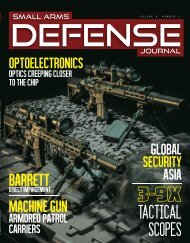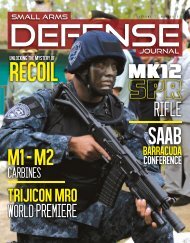SAR 20#2
Create successful ePaper yourself
Turn your PDF publications into a flip-book with our unique Google optimized e-Paper software.
system), 18,000 carbines (Mauser 98<br />
system) and 1,863 machine guns. Surplus<br />
weapons had to be handed over<br />
to the victors (although they often disappeared)<br />
and new developments were<br />
forbidden. The disarming of the people<br />
was also planned to reduce the danger<br />
of armed revolts provoked from different<br />
political groups.<br />
In midyear of 1920 the general disarming<br />
of the German and Austrian<br />
people was announced by the victorious<br />
powers. At a meeting of the German<br />
general staff on July 11, 1920 General<br />
von Seeckt told the other participants<br />
that about 2,700,000 rifles will have to<br />
be collected. About 600,000 of them are<br />
in the hands of the Einwohnerwehren<br />
(citizens’ militia). He also suggested<br />
they offer rewards for weapons that are<br />
handed over, or for information about<br />
hidden weapons.<br />
No date was fixed yet, but the German<br />
War Office reacted promptly. On<br />
August 4, 1920 the instruction number<br />
959 (with date August 1) “Marking of<br />
hand weapons and machine guns of the<br />
Reichswehr before the general disarming<br />
of the people” was published in the<br />
“Heeres-Verordnungsblatt” (Army Ordinances<br />
Gazette): The impending disarming<br />
makes it necessary for the army<br />
district commands to mark all the weapons<br />
in their possession, including cavalry<br />
units and military schools, with an<br />
unique distinctive identification-symbol.<br />
This ensured that during the collection,<br />
all weapons owned by the Reichswehr<br />
could easily be identified in the cases<br />
that they are found in the hands of unauthorized<br />
persons. The Annex of the<br />
instruction shows in graphics where the<br />
new identification-marking “1920” has<br />
to be placed on rifles, pistols, machine<br />
guns and their mounts, submachine<br />
guns, sabers, bayonets and lances.<br />
At the end of August, a reminder was<br />
published in the Army Ordinances Gazette<br />
to accelerate the marking of the<br />
weapons because the disarming action<br />
“is expected very shortly”.<br />
A more detailed explanation on how<br />
to handle the marking was published in<br />
the Army Ordinances Gazette on September<br />
28, 1920 as instruction number<br />
1123 “Marking of weapons of the Reichswehr<br />
/ Handing over of privately<br />
owned military weapons by disarma-<br />
OPPOSITE PAGE AND ABOVE TOP: Today the German Karabiner 98a<br />
can more often been found on the market with the "1920" marking than<br />
the Gewehr 98. The exact position of the mark on the receiver may vary.<br />
ABOVE CENTER: Bringing tears into collectors eyes: A pile of German<br />
weapons less all wooden parts, waiting for the furnace. Don't think about<br />
the value of this pile on the market today. ABOVE: Freikorps fighting in Berlin<br />
in November 1918. Note the Gewehr 98 and the Mauser Broomhandle.<br />
WWW.SMALLARMSREVIEW.COM 77 <strong>SAR</strong> Vol. 20, No. 2









